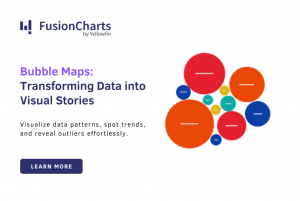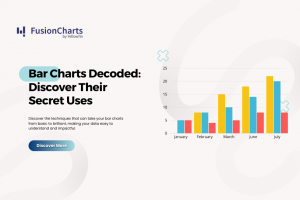Table of Contents
Two Goals in Data Visualization
In a business context, the two main goals that visualizations have are to:
- Explain
- Explore
1. Explain the Data to Tell a Story
As mentioned in the first post, the reason we visualize data is to tell a story. If the designer of the visual has a story to tell the viewer with the data, the goal of the visual is to explain. There is a defined structure starting from the main narrative, and trickling down to each part of the visual. These visuals are effective for making a point or conveying an insight from the data. For example, the main narrative in the simple column chart below is to highlight the country with the highest value:
The designer of this visual starts by asking a question of the data – Which is the highest value? – and designs the chart to simply answer this question. The viewer follows a similar process when interpreting the chart. This process can be understood by the following illustration:
- Answer a question. E.g., How much sales did we have last quarter?
- Support a decision. E.g., We need to stock more football jerseys as they were sold out on most days last week
- Communicate information. E.g., Revenue is on track for this quarter
- Increase efficiency. E.g., “Technical specifications” is the most viewed section on the product page. It should be given more visibility.
2. Explore Large Data Sets to Discover Many Stories
Explanatory visuals are not editorially driven, but rather are viewer-driven. The emphasis is not on a single important story but on discovering many small stories in the visual. The designer may not even be sure what story is there in the data. The aim of the designer is to present the data in a way that invites the viewer to notice the obvious and discover surprising insights. It simply gives away a number of ideas for the viewer to make something meaningful. For example, below is a visualization of the State of the Union address of recent Presidents:
 Here, the viewer starts by becoming familiar with the visual, then identifies an area of interest. For example, ‘Which President spoke most about jobs?’ She then explores the ‘Jobs’ section of the visualization and finds her answer – Barack Obama. She could then move on to exploring other areas of the visualization.
Here, the viewer starts by becoming familiar with the visual, then identifies an area of interest. For example, ‘Which President spoke most about jobs?’ She then explores the ‘Jobs’ section of the visualization and finds her answer – Barack Obama. She could then move on to exploring other areas of the visualization.
Exploratory visuals invite the viewer to get an overview of the visual, ask questions along the way, and find answers to those questions. The process can be illustrated as follows:
- Pose new questions
- Discover new areas of interest
The Hybrid Model
When viewing a visual, the easiest way to tell the type of visualization is to ask who does the work to reveal insights from the data. If the designer has done the work and made the insights clear, it’s an explanatory visual. If the viewer needs to find insights that the designer hasn’t made clear, it’s an exploratory visual. That said, most visualizations fall somewhere in-between. Most visualizations are based on a curated data set that allows some, or a lot of exploration. When designing a visualization it’s important to balance both elements – explanation, and exploration.
Now that we have a good understanding of the two goals of visualizations, let’s look at a few common examples that we come across in our daily lives.Examples From Daily Life
A Speedometer

This visual is designed to convey just one metric – speed. There is no exploration to be done here. It’s a great example of an explanatory visual.
The London Underground Map

The London metro map though packed with information is explanatory. It’s designed to show the best route from point A to B, and the designer has done the work to make it do just that. The viewer comes with the question ‘How do I get from point A to B?’, looks at the map, and finds the route.
Blog Tag Cloud

We’ve all seen tag clouds on blogs. They highlight the most-used tags from the blog, and in that sense are explanatory, giving emphasis to the bigger words. However, they also show many less frequent tags that invite exploration. They’re a great example of a hybrid visualization.
Google Maps

Google Maps is also a hybrid visualization. It can be used to explain the driving directions from point A to B, similar to the London Underground map – explanatory. It also allows zooming and panning to discover the surrounding areas, and landmarks – exploratory.
Google Hot Trends Fullscreen

If you’ve not come across this visualization, do take a look. It’s quite fascinating. It visualizes Google search queries in real-time in the form of a colorful grid. The queries keep changing every second. This visualization doesn’t highlight any single search query but rather invites the viewer to explore any part of the visual to find out what users are searching for right now. The story is left to the viewer to discover. This sort of visualization is possible only with the scale of big data. It’s a great example of an exploratory visualization.
Explain or Explore? The Choice is Yours
In summary, the two main goals of visualizations are to explain or to explore data. Most visuals are a hybrid of both goals. When designing a visual it pays to decide at the outset what balance the visual should have – more explanatory, or more exploratory. This single technique can greatly improve the quality of visualizations, and result in even better storytelling.
This post is the second in a series of posts. If you’d like to get the lowdown on what’s in this series from start to end, read our white paper ‘Principles of Data Visualization.’ You don’t even have to fill in a download form to read it. In the next post, we’ll dive into the mechanics of how we process visual information. We’ll consider the role of memory in perceiving visual information, and how to apply that understanding as we work with visualizations. Stay tuned!





betking88.club
October 31, 2018, 3:40 pmI appreciate, lead to I discovered exactly what I used to be taking a look for.
You have ended my 4 day long hunt! God Bless you man. Have a nice day.
Bye
Aplikasi Poker Handphone
November 21, 2018, 4:18 pmi loved this pot ! i read your blog fairly often and you’re always coming out with some great
stuff. i shared this on my Facebook and my followers loved it !
Keep up the good wor… 🙂